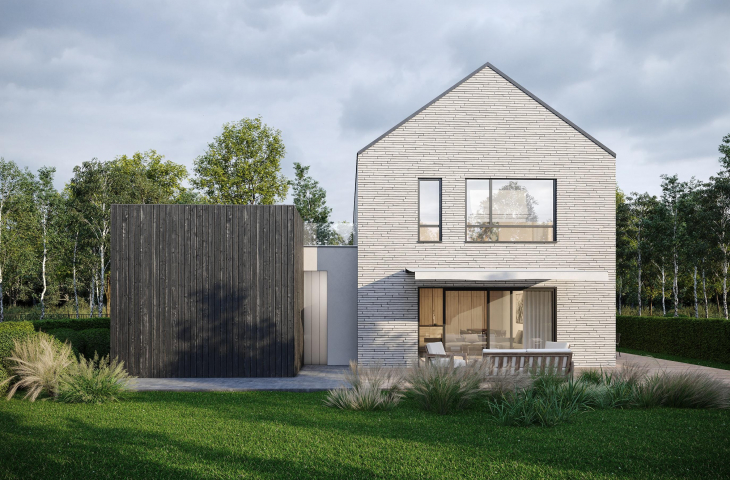Compact, tailored and simple, such is the single-family house under construction in Poznań from Ktura Architekci. Although the first discussions with the investor announced a different form of the building, the architects managed to optimize all the guidelines and create a simple building designed on two compositional axes.
At the very beginning of the work, the architects discussed with the investor, first of all, the size of the house, what is most important for its daily use and considered the sense of having a two-car garage.
The house was designed on two compositional axes
© Ktura Architekci
In the words of Katarzyna Buczkowska-Grobecka:
"We compacted a few dozen meters, designed the house for people, not cars, and created a dream yard in front of the house where family 'throws for three' can take place." Thus, by withdrawing the black garage-technical part towards the garden, we closed the terrace, creating a cozy lounge area, which is a continuation of the interior.
Also important in the whole project is the location of the fence. The architects decided to withdraw it, which freed up space, giving the possibility of free parking in front of the house. The house with a simple form was designed on two strong compositional axes, which can be seen in the development of the plot.
The house has the form of a simple barn, and the garage section is a simple cube
vision: VIZprofi Studio © Ktura Architects
Dobrawa Bies: What were the main design goals and what requirements did the investors set for you?
Katarzyna Buczkowska-Grobecka: I can reveal that the investors came to me with a "ready-made" idea for a house - literally it was drawn to scale on a sheet of checked paper :). Although at first I did not analyze the layout at all, it still made quite an impression on me. Even then I knew that the investors had been thinking about it for a long time and wanted it to be perfect for them. Even then, the house was to be much larger, spread out with a large two-car garage. Its body was to be largely covered with a flat roof.
Dobrawa: What is the shape of the house based on?
Catherine: The shape of the house, i.e. the whole project, is first and foremost discussions with the investor, a detailed interview, more than one on-site visit and, of course, the local plan and the context. All this evenly makes up the concept of the whole. You can't let go of any piece of this puzzle or forget that it is the chosen designer who puts these blocks together and creates a new space for the investor and also for the neighborhood.
The withdrawal of the garage towards the garden created a relaxation zone
© Ktura Architekci
Dobrawa: What materials were used and how did their selection influence the design?
Catherine: I am very open-minded when it comes to materials. I define them every time as X, Y and sometimes still Z values... Never a material in my projects will significantly affect the design. Good architecture will always defend itself, no matter what it is dressed in. This is always a "secondary" issue for me, however it sounds. In this matter, I listen strongly to investors and what they feel like. For them, this is often a very important aspect. I always manage it in my houses :) That's exactly what happened in this case, too.
Dobrawa: Where did the idea for such a contrasting facade come from?
Catherine: This house is primarily the form of a dominant simple barn and will be perceived as such. The withdrawn - garage-technical part complements it, it is additionally cut off in form, which gives us the opportunity to contrast the elevation freely.
The bright facade of the house contrasts with the black garage
vision: VIZprofi Studio © Ktura Architekci
Dobrawa: Are simple synthetic forms easier to design, but does it require "decision-making discipline"?
Catherine: For me, every project requires discipline and a tremendous amount of work. You have to bite into it just as hard every time and take your quiet time - that's the most important thing. Simple forms, which are actually noticeable in my projects, require the same amount of work each time, it's not a template or any repetitiveness. In such synthetic designs you can't squeeze or stuff anything, and that's what's fascinating about them. At the end we look at these plans, at the whole project and it has arms and legs, here everything sits, here everything plays, here nothing is by chance. This is the most exciting part of our work. It never gets boring!

































